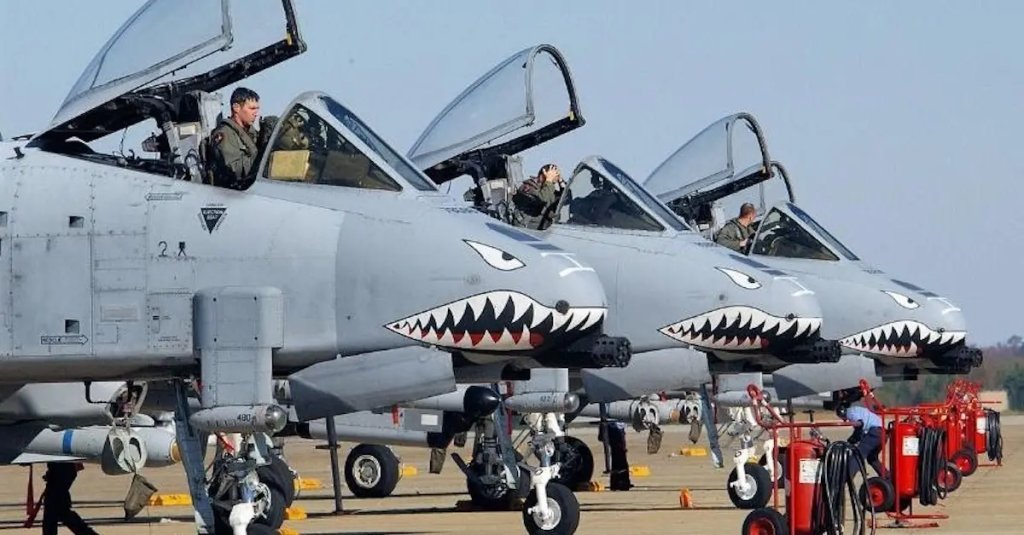

Today, the Fairchild Republic A-10 Thunderbolt II, affectionately known as the “Warthog” or “Hog,” is the premiere close air support aircraft of the United States Air Force. The Warthog is best known for the massive 30mm GAU-8 Avenger rotary cannon fitted in its nose. Further highlighting this feature, the aircraft’s nose is often painted with a warthog head or shark mouth. Most fans of the Warthog believe the latter nose art to be derived from the famous shark mouthed P-40 fighter planes of the Flying Tigers, and this is partly true. However, the true origin of shark mouth nose art goes all the way back to the genesis of aerial combat.
WWII enthusiasts will be familiar with the American Volunteer Group of the Chinese Air Force, better known as the “Flying Tigers”. Their Curtiss P-40 Warhawk fighter planes were painted with a distinct shark mouth nose art—partly as a form of psychological warfare, partly as self-expression, and generally as a display of aggression. These motivations are echoed in the Warthog with its own shark mouth nose art, but the Flying Tigers didn’t come up with the idea on their own.

Doug Revell of WARBIRDS INTERNATIONAL did some research on this topic and found that the Flying Tigers were actually inspired by 112 Squadron of the British RAF. 112 Squadron was one of the first to receive the P-40 Tomahawk (the British Commonwealth and Soviet name for the P-40B and P-40C variants of the Warhawk). The large air intake on the P-40’s nose lent itself to the aggressive shark mouth feature. The Flying Tigers saw a photograph of 112 Squadron’s shark mouthed Tomahawks operating in North Africa, and adopted the design for themselves. However, while the RAF inspired the Flying Tigers with their shark mouth nose art, they too drew inspiration from another country’s pilots.

112 Squadron had encountered the Luftwaffe’s Zerstörergeschwader (heavy fighter wing) 76 earlier in the war. ZG 76 flew Messerschmitt Bf 110 heavy fighter/fighter-bombers which they decorated with shark mouth nose art, though notably without the inclusion of eyes. Other variations of shark mouth nose art existed on German-made aircraft including shark mouth art on the lower engine cowling of Swiss Air Force Messerschmitt Bf 109s and a shark mouth with round eyes on the nose a Focke-Wulf Fw 190 fighter. However, it was the shark mouths of ZG 76’s Bf 110s that inspired 112 Squadron to adopt the shark mouth with the addition of the teardrop-shaped eyes.

Revell was able to trace ZG 76’s shark mouthed Bf 110s back to a German Air Force reconnaissance plane in the First World War. “The first noted mouth was on a World War I German Roland C.II,” Revell said. “The design fell into disuse in the interwar period but reappeared on the ZG 76 Me 110s (the unofficial but more commonly used name for the Messerschmitt Bf 110) operating from Norway…” The Walfisch (German for whale), as the C.II was called, was often painted with an open shark mouth and beady eyes on its nose. ZG 76 omitted the beady eyes when they adopted the shark mouth for their Bf 110s during WWII.

With the more commonly known history of the Flying Tigers, it’s difficult to imagine that the shark mouth art on the nose of the Warthog can be traced back to a WWII Luftwaffe heavy fighter and a WWI German recon plane. In a way, these historical connections are appropriate, since the Warthog is used to provide forward air controller-airborne support (like the C.II) as the OA-10 and close air support for ground troops (like the Bf 110). Despite the Air Force’s intention to replace the A-10 with the Lockheed Martin F-35 Lightning II, support for the Warthog from troops on the ground and the pilots that fly it are helping to ensure that the shark mouth tradition lives on in the skies.
Featured image: 23rd Fighter Group A-10 Thunderbolt IIs featuring the distinctive shark mouth nose art. (Photo by Air Force SSgt Nathan G. Bevier/Released)
